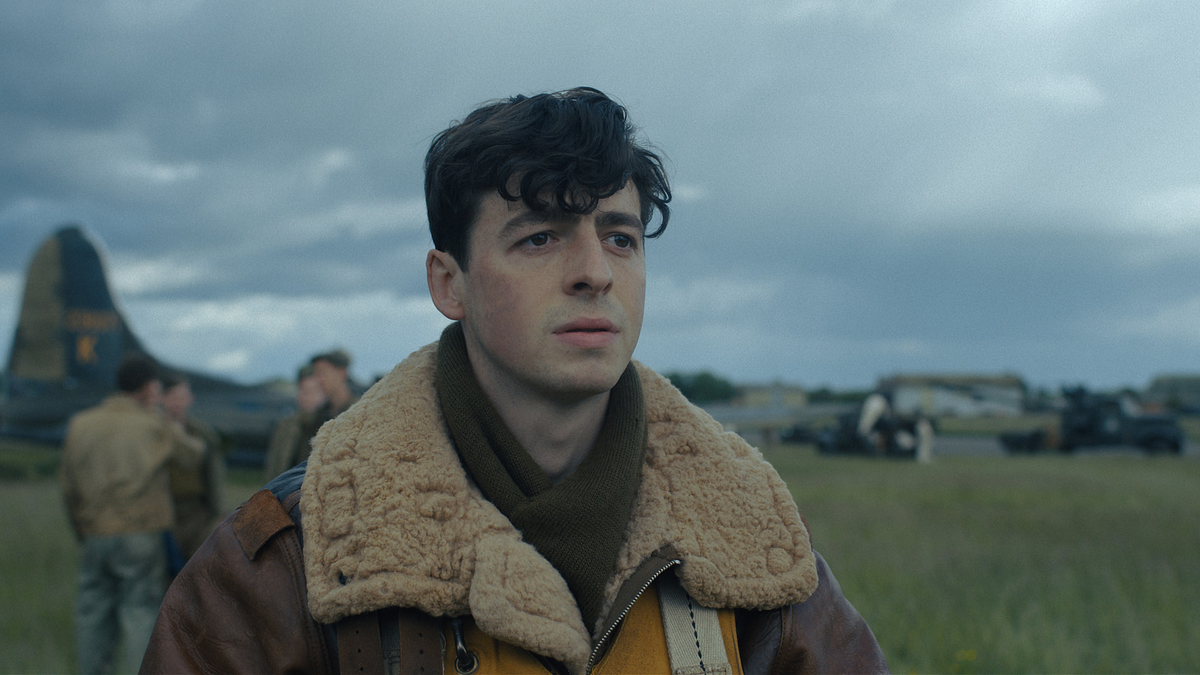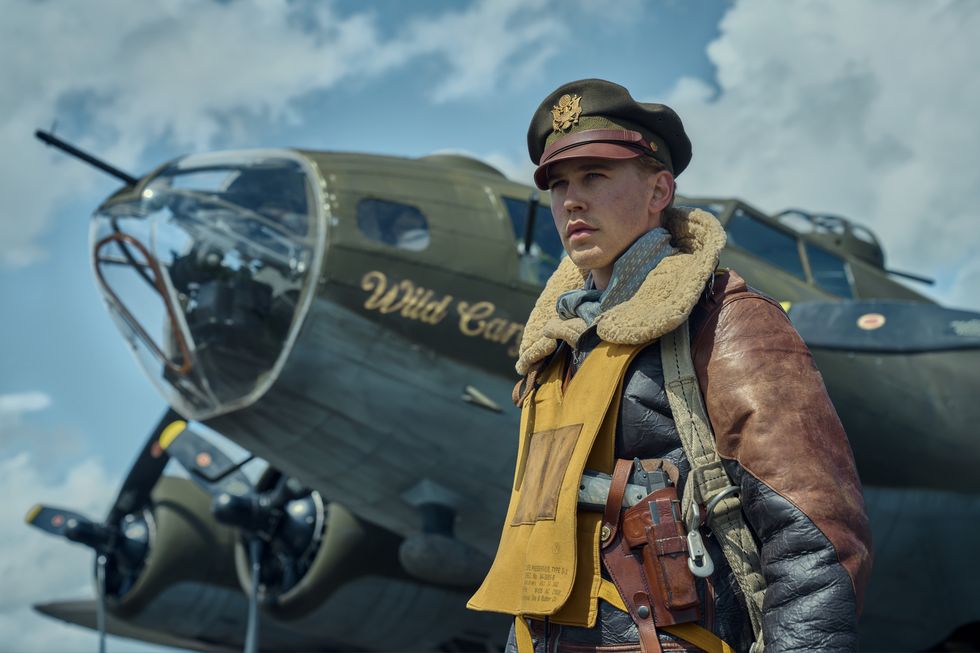In the swirl of young men in shearling jackets who populate Masters of the Air, there’s one you’ll definitely be able to get a fix on. Harry Crosby, played by Anthony Boyle, narrates the action as the 100th bomb group sets out to wear down the Nazi war machine from its base in East Anglia. Crosby – known to most as Croz – formed the backbone of the story with his his memoir "A Wing and a Prayer", and it’s through his eyes that everything plays out.
When Pearl Harbor was attacked on 7 December 1941 Crosby was studying at the University of Iowa, but he paused his studies to sign up with the Air Corps a week later. He left his home town of Oskaloosa expecting to be fighting in the Pacific as a pilot, but after a few weeks’ training jumped to being a second lieutenant navigator. It took him another 17 months to get to the war in Europe.
“I don’t know what to think about it,” he wrote to his father just before he left America. “I’m rather scared – that’s a big ocean to cross and a pretty big war when I get there.”
Still, he was exploring the world beyond Iowa. Crosby was born in 1919, and his older sister died when she was seven and he was five. His parents were “mismatched”; his mother was “stern, judgemental, while his father “enjoyed all the sins: drinking, gambling, womanising”. Crosby was brought up with a Calvinist work ethic and taught to push difficult feelings deep down. He was told not to cry or to question authority. He never hugged another man, not even his father. “When I saw an Italian boy kiss his father once I turned my head so I wouldn’t have to look,” he wrote.
He was assigned to fly on Boeing B-17 bombers, the model rechristened the ‘Flying Fortress’ by a Seattle Times reporter for the number of machine gun positions. They weren’t exactly safe though. “The first time I ever saw a B-17 land,” Crosby wrote, “it came in at night and crashed, killing the entire crew.”
He didn’t have a great deal of faith in his ability to get his crew where they needed to be, either. He frequently worried about getting lost over water. “Either because our training was inadequate or because I was not fitted for the job, I had little reason to develop confidence about my ability as a navigator,” he wrote.
He and the rest of the 418th squadron of the 100th bomber group – the Bloody Hundredth, as they’d come to be known for the terrible toll which their daylight runs took on crews – flew to Warton in Lancashire and then to their base at Thorpe Abbotts in Norfolk. On 28 June 1943 Crosby flew his first mission to hit submarine pens in Saint-Nazaire on France’s Atlantic coast. In a cloud of flak, a shard of shrapnel punched a hole in the fuselage 15 inches above Crosby’s head. He’d been afflicted by airsickness, regularly getting through five sickbags per trip.
By November that year Crosby was promoted to lead navigator for the 100th bomb group, a responsibility which weighed on him but did at least mean he puked less. “Apparently freedom from airsickness came with being a lead navigator,” he wrote.
By the end of the war Crosby had flown 32 combat missions. Some were what crews called ‘milk runs’, or simple missions with little opposition. Others were less straightforward: on one run his plane was riddled with 1200 bullet holes. On another, he was navigating a formation of bombers toward a target city when he realised that it was Bonn in the west of Germany. Realising that Bonn was where Beethoven went to school, Crosby decided they couldn’t bomb it and moved the mission elsewhere.
After the war he went back to university in Iowa, and got a PhD from Stanford University. He was also awarded the Distinguished Flying Cross, the Air Medal, the Bronze Star, and the Croix de Guerre. He died in 2010 aged 91.
His own feelings about his time in the war were ambivalent. At the end of his memoirs, Crosby recalls a passage from another book, which relates a slightly hammy homily where a European father tells his frightened daughter that the sound of bombers is “the music of angels”.
“Was it worth it? Those years? Those lives? That destruction? I still don’t know,” Crosby wrote. “But I do know that I, too, heard the angels.”
Who was Major Gale ‘Buck’ Cleven?
Warning: this article contains spoilers for Masters of the Air. If you don’t want to know what happens, definitely don’t read this.
Austin Butler’s Major Gale ‘Buck’ Cleven might be the most intensely Austin Butler character he’s yet managed to play. He’s pining for his best gal Marge, murmuring in a slightly cowboyish twang, looking glorious even while wrangling a B-17 in the teeth of heavy flak and German fighter planes. The real Buck Cleven, though, wasn’t a million miles away from that.
Bucky was a common nickname in the 100th bomber group – the group navigator Harry ‘Croz’ Crosby records three separate Buckys in his memoir – and Cleven picked up his when he signed up as a flying cadet in Texas in 1940 where he met his friend John Egan, played by Callum Turner in Masters of the Air.
“Cleven and Egan were best friends, top flyers, devil-may-care,” Crosby wrote. “All the 100th pilots wanted to be like them.”
Cleven was rather fuller of face and more cherubic than Butler, but as he was promoted repeatedly through his training in America he picked up something of an aura. By the time he’d shipped out to Thorpe Abbotts in Norfolk he was a major, and practically a rock star.
“I don’t normally use the word ‘debonair’, but that’s what they are,” wrote Crosby. He fitted the image of the daring airman which Hollywood had minted. “Bucky Cleven and Bucky Egan are like what their men saw in the movie I Wanted Wings. The men wanted leaders like that. Cleven’s real first name is Gale, and Egan’s is John, but I never heard either name used.”
Cleven was given command of the 350th bomb group and flew his first mission on 25 June 1943 to Bremen, but it was the raid on Regensburg on 17 August that made Cleven’s name. In his article ‘I Saw Regensburg Destroyed’, the Saturday Evening Post writer and brigadier general Beirne Lay called it “the young squadron commander’s finest hour”.
The plan was to attack the German aircraft industry at Regensburg and Schweinfurt, but American bombers met heavy resistance in the air. Cleven’s plane got to Regensburg with one crew member already dead and another injured, and the plane’s hydraulics and electrics shredded. Then a shell hit the front of the plane and took a chunk of the nose off. “None of us expected to get to Africa,” Crosby wrote later. “This was the end.”
The pilot called for the crew to bail out and hit the alarm bell, but was cut off by Cleven – “using blunt language,” as Lay recorded – who took over the controls and nursed the plane to North Africa. Cleven’s luck appeared to have run out during a raid on 8 October, when his plane was one of several shot down during a raid over Bremen. Unable to make it to the Dutch border, Cleven ditched his plane and was captured by a pitchfork-wielding German farmer. He ended up in Stalag Luft III near Sagan in Poland. His old friend Bucky Egan soon joined him there, and greeted him with a cheery “What the hell took you so long?”
Conditions were brutal, but the inmates were able to keep tabs on what was happening in the war with jerry-rigged crystal radios. After the D-Day landings they began preparing for the possibility that they’d have to make a run for it themselves as the war’s fronts closed in around them. They were forced to evacuate the camp on 27 January 1945, and marched for mile after mile as men dropped dead, were shot, or made a run for it. Cleven took his chance somewhere near Moosburg. After 12 days on the run through Europe, he made it back to Abbotts Thorpe.
After the war Cleven stayed active in the Air Force through the Korea and Vietnam wars, and the two Buckys stayed close: Egan was Cleven’s best man when he married his longtime girlfriend Marjorie. He retired from the services with the rank of colonel in 1955, and after getting an MBA and a PhD in interplanetary physics spent much of the rest of his career in academia making Webber College in Florida a well-regarded business school. He died in 2006 aged 87.
His reputation as the epitome of the dashing pilot endured long after. “When Bucky Cleven and Bucky Egan were setting the tone of the 100th, there was dash,” Crosby wrote. “There was derring-do. Flying the war was an adventure.”














